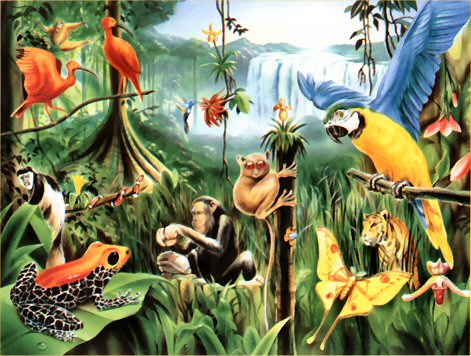TIGER
Tiger is known as (Panthera tigris),is the largest cat species reaching a total body length of up to 3.3 m (11 ft) and weighing up to 306 kg (670 lb).
Subspecies
Bengal tiger-
lives in India, Nepal, Bhutan, and Bangladesh, and is the most common subspecies, with populations estimated at less than 2,500 adult individuals.
Indochinese tiger - Found in Cambodia, China, Laos, Burma, Thailand, and Vietnam. These tigers are smaller and darker than Bengal tigers. Males weigh from 150–195 kg (330–430 lb), while females are smaller at 100–130 kg (220–290 lb). Their preferred habitat is forests in mountainous or hilly regions.
Malayan tiger - Exclusively found in the southern part of the Malay Peninsula, was not considered a subspecies in its own right until 2004. The new classification came about after a study by Luo et al. from the Laboratory of Genomic Diversity Study, part of the National Cancer Institute of the United States. According to official government figures, the population in the wild may number around 500 individuals, but is under considerable poaching pressure. The Malayan tiger is the smallest of the mainland tiger subspecies, and the second-smallest living subspecies, with males averaging about 120 kg (260 lb) and females about 100 kg (220 lb) in weight.

Sumatran tiger - Is found only on the Indonesian island of Sumatra, and is critically endangered. It is the smallest of all living tiger subspecies, with adult males weighing between 100 and 140 kg (220 and 310 lb) and females 75 and 110 kg (170 and 240 lb). Their small size is an adaptation to the thick, dense forests of the island of Sumatra where they reside, as well as the smaller-sized prey. The wild population is estimated at between 400 and 500, seen chiefly in the island's national parks.

Siberian tiger - Also known as the Amur tiger, inhabits the Amur-Ussuri region of Primorsky Krai and Khabarovsk Krai in far eastern Siberia.It ranks among the largest felids ever to have existed, with a head and body length of 160–180 cm (63–71 in) for females and 190–230 cm (75–91 in) for males, plus a tail of about 60–110 cm (24–43 in), with adult males weighing between 180 and 306 kg (400 and 670 lb) and females 100 and 167 kg (220 and 370 lb). The average weight of an adult male is around 227 kg (500 lb). Siberian tigers have thick coats, a paler golden hue, and fewer stripes.The heaviest wild Siberian tiger weighed 384 kg (850 lb), but according to Mazák, this record is not reliable. In 2005, there were 331–393 adult and subadult Siberian tigers in the region, with a breeding adult population of about 250 individuals.

South China tiger- Also known as the Amoy or Xiamen tiger, is the most critically endangered subspecies of tiger, and is listed as one of the 10 most endangered animals in the world. One of the smaller tiger subspecies, the length of the South China tiger ranges from 2.2–2.6 m (87–100 in) for both males and females. Males weigh between 127 and 177 kg (280 and 390 lb) while females weigh between 100 and 118 kg (220 and 260 lb). From 1983 to 2007, no South China tigers were sighted.
Extinct subspecies
Bali tiger- Was limited to the Indonesian island of Bali, and was the smallest subspecies, with a weight of 90–100 kg (200–220 lb) in males and 65–80 kg (140–180 lb) in females.Bali tigers were hunted to extinction—the last Bali tiger, an adult female, is thought to have been killed at Sumbar Kima, West Bali, on 27 September 1937. There is no Bali tiger in captivity. The tiger still plays an important role in Balinese Hinduism.
Caspian tiger- Also known as the Hyrcanian tiger or Turan tiger was found in the sparse forest habitats and riverine corridors west and south of the Caspian Sea and west through Central Asia into the Takla-Makan desert of Xinjiang, and had been recorded in the wild until the early 1970s. The Amur tiger is the genetically closest living relative of the Caspian tiger.
Javan tiger- Was limited to the island of Java, and had been recorded until the mid-1970s. Javan tigers were larger than Bali tigers; males weighed 100–140 kg (220–310 lb) and females 75–115 kg (170–250 lb). After 1979, no more sightings were confirmed in the region of Mount Betiri
Hunting and diet
In the wild, tigers mostly feed on large and medium-sized animals, with most studies indicating a preference for native ungulates weighing 90 kg (200 lb) at a minimum. Sambar, chital, barasingha, wild boar, gaur, nilgai and both water buffalo and domestic buffalo, in descending order of preference, are the tiger's favoured prey in India. Sometimes, they also prey on other predators, including other large species, such as dogs, leopards, pythons, sloth bears, and crocodiles. In Siberia, the main prey species are manchurian wapiti and wild boar (the two species comprising nearly 80% of the prey selected) followed by sika deer, moose, roe deer, and musk deer. In Sumatra, sambar, muntjac, wild boar, and Malayan tapir are the predominant prey. In the former Caspian tiger's range, prey included saiga antelope, camels, Caucasian wisent, yak, and wild horses. Like many predators, they are opportunistic and will eat mcauch smaller prey, such as monkeys, peafowl, other large, ground-based birds, hares, porcupines, and fish.
Common Prey






.jpg)


